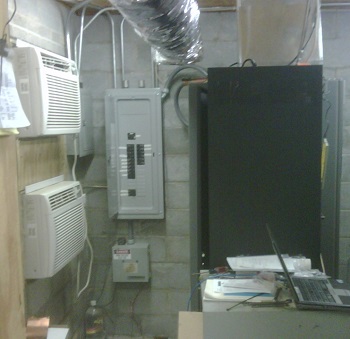
Extending the Life of your Transmitter
This article comes at an opportune time – I’m sitting in a hotel after having visited several sites in the upper Midwest and there are a couple of things on my mind. A lot of this was covered in a very recent webinar on transmitter reliability that Chuck Kelly and I did (archived here). However, most of it bears repeating and, as we enter what appears to be working up to a tumultuous summer storm season, it’s going to be very relevant.
One of the first things I noticed about the five sites I’ve been to in the past week is that there are still a lot of challenges with air handling. Definitely a sealed, air conditioned site (with a properly rated air conditioner) is a good thing, but if the cool air isn’t being directed through the transmitter, you are still going to have hot spots and that is NOT a good thing!
 This photo is from a site I encountered in my travels a year or two ago; the silver pipe at ceiling level is the cold air supply to the room from the air conditioner. The ‘hole in the wall’ directly below the pipe is the return supply from the room to the air conditioner.
This photo is from a site I encountered in my travels a year or two ago; the silver pipe at ceiling level is the cold air supply to the room from the air conditioner. The ‘hole in the wall’ directly below the pipe is the return supply from the room to the air conditioner.
The way this is set up, the return is pulling air from the room directly behind the transmitter – which is where the transmitter’s air intake is located. Therefore, the transmitter is being starved for air and the PAs and power supplies were running pretty warm, in spite of a well air conditioned room which felt nice and cool.
The solution was to effectively reroute the air conditioner ports so that cool air entered the room behind the transmitter and the warm air return was taken from ceiling level above the transmitter.

Here’s the resolution.
The two wall units behind the transmitter were added for backup – as far as I know, they’ve never been needed. The silver pipe (cold air supply) is now pointed down behind the transmitter, so that cold air goes where it’s needed and a return duct was added above the transmitter to remove heated exhaust air.
The operating temperature of the PAs and power supplies dropped by well over 20 degrees, with total cost to effect the improvement being minimal (the backup units were added as an overkill measure and aren’t factored into this cost, since they were the real solution to the problem at hand.)
While, as mentioned above, air conditioning is the ideal solution, for many sites, especially in the upper 50 degrees of latitude, forced air systems are perfectly acceptable.
However, if you are not forcing air into the room, but simply pulling it out with an exhaust fan, you are creating a negative pressure situation that will draw dust in through every crack and crevice in the building.
Since dust buildup on heatsinks and components reduces their ability to transfer heat, this can lead to long term problems as well. Always, intake air should be forced in – at a rate greater than the transmitter’s air throughput rate, and then exhaust air removed (preferably with a slightly smaller exhaust fan). This creates positive pressure in the room, which helps to keep the dust out, keeping the room cleaner and the electronic equipment happier.
Here’s a shot from a slide that Chuck used during our recent webinar.

With this layout, we’ve got positive pressure in the room and a backup system in the event of a failure of the intake blower. As the transmitter exhaust duct is the primary exit point for heated air to leave the room, airflow through the transmitter is maintained – just remember to clean or replace the intake air filters on a regular basis!
 One other thing I noticed over the past week was a lot of compression clamps in ground systems. While these are very convenient and not so much an issue with solid copper conductors, over time they will tend to become loose, as the copper strands of a stranded ground wire compress inside the clamp.
One other thing I noticed over the past week was a lot of compression clamps in ground systems. While these are very convenient and not so much an issue with solid copper conductors, over time they will tend to become loose, as the copper strands of a stranded ground wire compress inside the clamp.
The ideal solution is to always braze, silver solder or CAD weld any ground connection – as these become loose, or the copper oxides, they get resistive and lightning will start to look for alternate paths between ground and the power lines – frequently through equipment power supplies!
Here we see a station owner fixing a ground connection… after I walked up to it and pulled the primary ground from the transmitter room right out of the clamp connecting it to the ground rod!
We have a white paper on grounding and lightning protection, so I won’t rehash all of that.
Next time you are out at the site, take a moment to start at your tower and imagine you are a lightning bolt carrying several thousand amps of current, looking for a place to dissipate – either to earth or through the thousands of miles of wire that the power company so graciously runs to the transmitter building. Each time you find a connection between your path and either of these destinations check the connections – and make sure that there is a good surge protector in place to route lightning energy from ground to the AC lines, rather than through equipment!
 Finally, this seems to be a banner year for certain other transmitter site residents, especially in my part of the world.
Finally, this seems to be a banner year for certain other transmitter site residents, especially in my part of the world.
This photo is a little friend I made during one of my site visits this week. So, when you are out and about, make sure you have a good insecticide with you and don’t be afraid to use it. I know I will be adding a can to my travel case!
That wraps it up for this issue – until next time, be safe and happy engineering!
Jeff
Jeff Welton, has worked with Nautel for 25+ years. He is currently the Nautel Sales Manager for U.S. Central Region but previously he spent 16.5 years as a Nautel Customer Service Technician.
Submissions for this Tips ‘n Tricks column are encouraged and if published you’ll receive a Nautel T-shirt. Submissions should be typed and emailed, with high resolution photos, to [email protected] using the subject line Tips ‘n Tricks.

